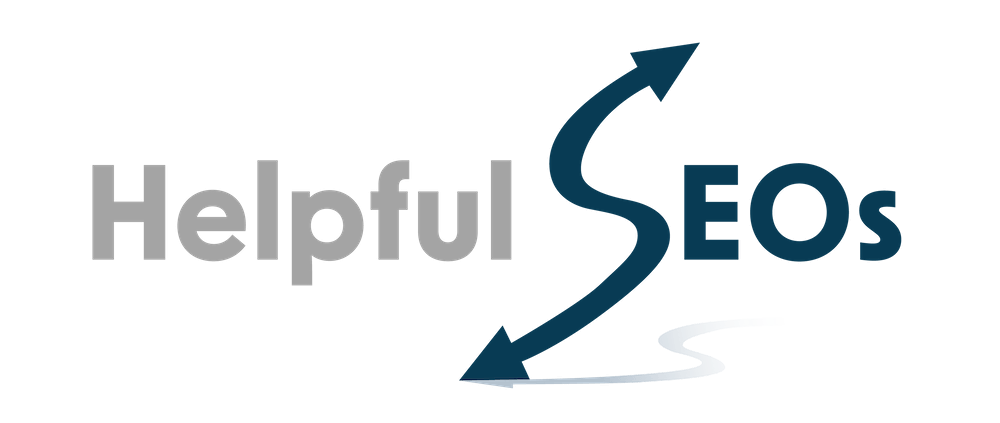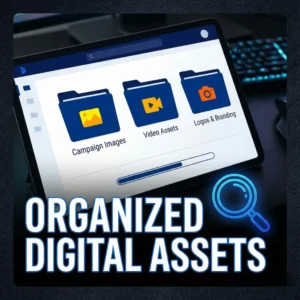Many companies lack an organized way to manage their large pool of content marketing assets, which can sometimes result in valuable content being lost in a ‘content void.’
For example, you may have sales enablement assets that a new salesperson never discovers, but could have helped them advance or close a sales opportunity.
Salespeople sometimes ‘reinvent the wheel’ by making a new presentation or document when one already exists.
Additionally, with the right system in place, marketers can plan new content more effectively, update existing content more quickly, and distribute it across various channels.
MAM vs. DAM
From our content marketing and SEO perspective, a marketing asset management (MAM) system serves as a central repository for all content marketing assets with a URL. The MAM system makes these assets easily accessible to users within an organization, enabling content marketers to manage them effectively.
This differs from a digital asset management system (DAM), which also serves as a storage repository for media, such as images and videos. Records in a MAM can have URLs that reference stored media assets.
Marketing Asset Types
By ‘marketing asset,’ we mean any content that took time and/or money to create—all of the following asset types qualify. You may think of others.
| Asset Type | Description |
|---|---|
| Blog Post | This one is self-explanatory |
| Standard Page | Your website’s homepage, product & service pages, about, contact, testimonials, etc. |
| Landing Page | A page with the primary goal of visitor conversion |
| Gated PDF | The gated content behind landing pages |
| Microsite | A sales room type site on a platform like OneMob |
| Case Study | A customer case study PDF |
| Tool | A free tool offered to your visitors, such as a calculator |
| Video | A video on any platform, including YouTube, Vimeo, Wistia, and Vidyard |
| Audio | A podcast episode player link (Apple Podcasts, Spotify) or a SoundCloud link |
| Map | A Google My Map or an ArcGIS Online type map |
| LinkedIn Pulse Article | A long-form post on LinkedIn |
| Link-in-bio | A link-in-bio on a platform like Gravatar, Linktr.ee, or Bit.ly |
Investopedia defines an asset as “a resource with economic value that an individual, a company, or a country owns or controls with the expectation that it will provide a future benefit.”
A marketing asset is conceptually similar to a physical business asset. You spent money to create or acquire it, expecting it to produce or contribute toward a financial return.
Here are five ways to manage your valuable content marketing assets.
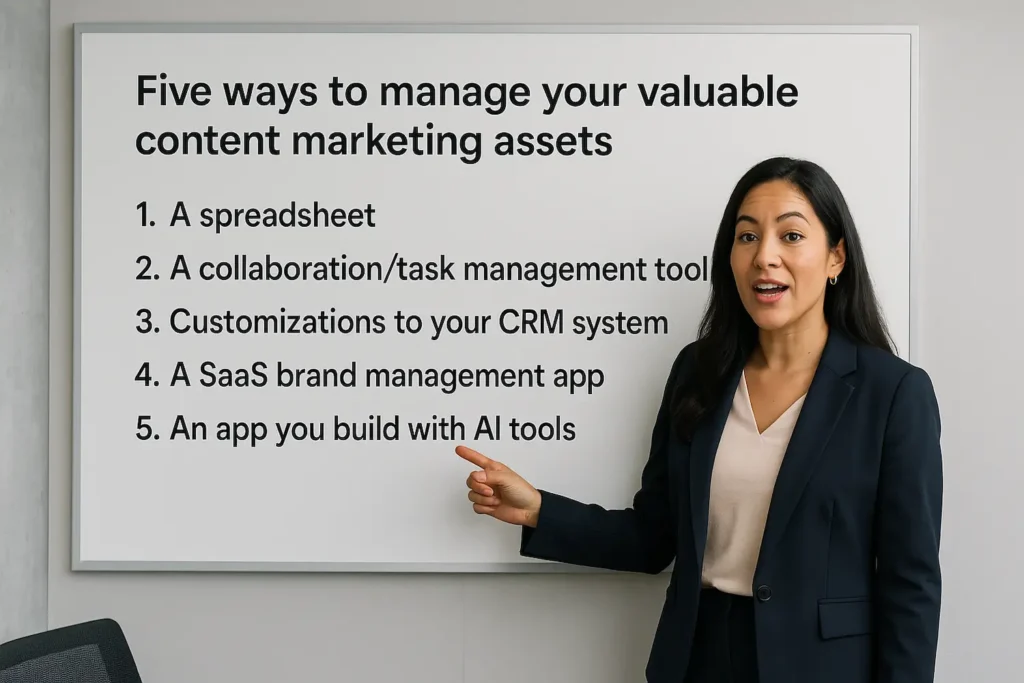
A spreadsheet
Using a spreadsheet as an asset management tool is often the most straightforward approach. Creating and sharing a spreadsheet with as many users as needed incurs no incremental cost.
However, for many of the same reasons that spreadsheets have limitations for functions like CRM and accounting, a spreadsheet is not the ideal management tool.
There is no global search or relational database capability, and user edits are not audited. Records (rows) can be accidentally deleted.
A collaboration and task management app (like ClickUp)
In an app like ClickUp, you can manage your marketing assets by creating a folder called ‘Content’ or ‘Marketing Assets,’ a list for each asset type, and adding assets as tasks within each list.
ClickUp allows custom fields and statuses to be added on a list level.
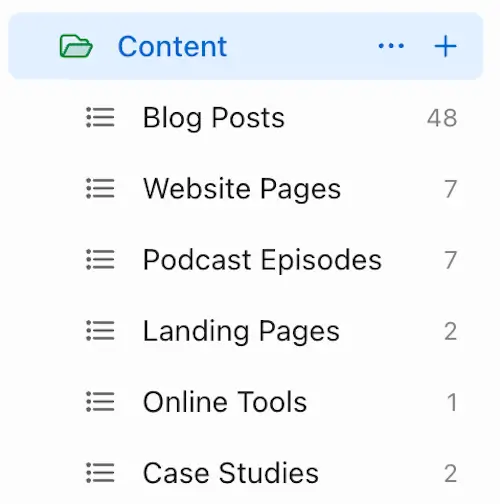
For small teams, ClickUp is reasonably priced.
Custom objects and page layouts in a CRM system
Internally, we built a marketing asset management system inside our CRM using custom tables and fields.
With the power of a database, this form of MAM can relate clients to content and content to links, personas, and keywords.
A global search makes it easy for users to find assets.
Here is part of the schema we created.
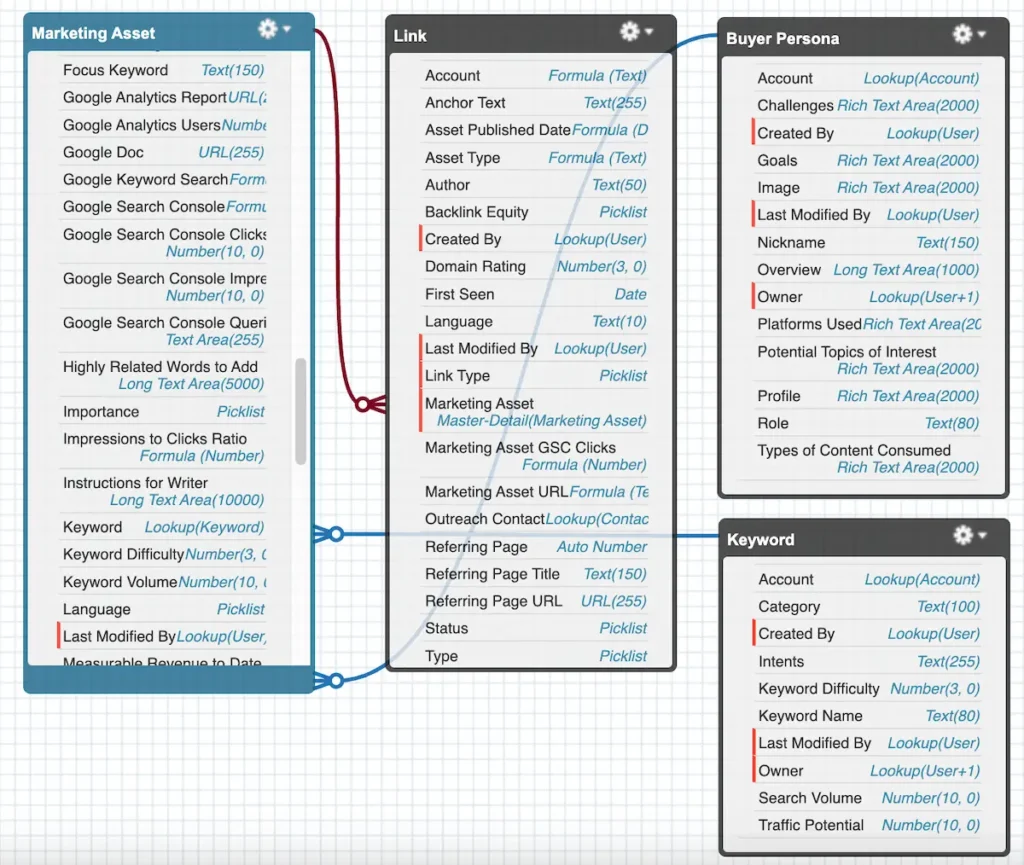
Here is a list view, sorted by the most recent edit to the record in CRM.
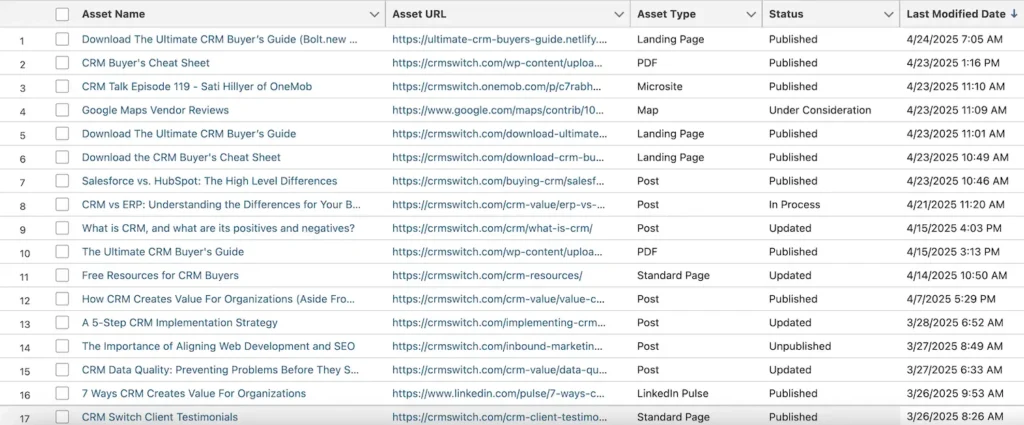
The disadvantage of using a CRM system is that some team members who need access to marketing asset information may not be licensed CRM users, and user licensing for a highly configurable CRM platform is relatively expensive.
A SaaS brand management app you subscribe to
Paid apps for managing assets are available. These tend to be enterprise-oriented DAMs and brand management systems, such as Smartsheet’s Brandfolder.
This type of app goes far beyond essential marketing asset management.
Brandfolder’s features include Adobe Creative Cloud integration for seamless asset editing, AI-driven tagging and analytics for enhanced asset discoverability, customizable branding options, and user management to streamline workflows across teams.
A MAM app you build with AI tools
Anyone can build an app using a prompt-driven full-stack AI development tool like StackBlitz’s Bolt.new, Netlify for app hosting, and Supabase as the back-end database.
A newer, all-inclusive option is Mocha.
We began developing a marketing asset management system using this stack, based on the design we created in CRM.

The advantage of this approach is that subscription costs include as many users as you want.
At the time of publication, the Pro versions for these three apps cost a total of $62 per month.
Whether you use a free spreadsheet or buy or build a marketing asset management system, this tool will save staff members a significant amount of time and can increase revenue.
